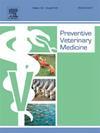Prevalence and risk of orthopedic diagnoses in insured Swedish Warmblood horses
IF 2.2
2区 农林科学
Q1 VETERINARY SCIENCES
引用次数: 0
Abstract
Sweden has a strong tradition of insuring horses for veterinary costs, and orthopedic diagnoses are the most common for insurance claims. The aim of this study was to investigate differences in prevalence and risk of orthopedic diagnoses for Swedish warmblood (SWB) horses classified as jumping (J) or dressage (D) horses. Also, other factors that may influence orthopedic health were investigated, i.e., sex, birth cohort, and participation in young horse tests and competition. The data consisted of 15,619 insured SWB horses born between 2010 and 2020. Horses were classified as J or D horses according to pedigree. The prevalence of orthopedic diagnoses was investigated using logistic regression analysis and presented as Least Squares means. The time from birth to first orthopedic diagnosis was investigated using survival analysis. D horses were at a higher risk of having orthopedic diagnoses compared with J horses (50.9 % vs 43.9 %, P < 0.0001). Male horses were at a higher risk than females (49.7 % vs 45.0 %, P < 0.0001), and tested horses were at a higher risk than non-tested horses (49.9 % vs 44.9 %, P < 0.0001). No significant difference was seen between competed and non-competed horses regarding the risk of having orthopedic diagnoses, but the groups were predisposed to different subgroups of orthopedic diagnoses. Survival analysis showed that later cohorts were more likely to have insurance claims for orthopedic diagnoses at a younger age than earlier cohorts. In conclusion, insurance data can be a useful tool to study which factors influence the orthopedic health status of the SWB horse population.
瑞典温血马骨科诊断的患病率和风险
瑞典有很强的传统,为马匹投保兽医费用,而骨科诊断是保险索赔中最常见的。本研究的目的是调查瑞典温血马(SWB)分为跳跃马(J)和盛装舞步马(D)的患病率和骨科诊断风险的差异。此外,还调查了其他可能影响骨科健康的因素,即性别、出生队列和参加小马测试和比赛。数据包括2010年至2020年间出生的15,619匹投保的SWB马。马根据血统分为J马和D马。骨科诊疗率采用logistic回归分析并以最小二乘法表示。从出生到首次骨科诊断的时间采用生存分析进行调查。与J马相比,D马有更高的骨科诊断风险(50.9 % vs 43.9 %,P <; 0.0001)。公马的风险高于母马(49.7 % vs 45.0 %,P <; 0.0001),接受测试的马的风险高于未接受测试的马(49.9 % vs 44.9 %,P <; 0.0001)。参赛马和非参赛马在患骨科疾病的风险方面没有显著差异,但各组易患骨科疾病的亚组不同。生存分析显示,年龄较晚的队列比年龄较早的队列更有可能在年轻时进行骨科诊断的保险索赔。综上所述,保险数据可以作为研究影响SWB马种群骨科健康状况因素的有用工具。
本文章由计算机程序翻译,如有差异,请以英文原文为准。
求助全文
约1分钟内获得全文
求助全文
来源期刊

Preventive veterinary medicine
农林科学-兽医学
CiteScore
5.60
自引率
7.70%
发文量
184
审稿时长
3 months
期刊介绍:
Preventive Veterinary Medicine is one of the leading international resources for scientific reports on animal health programs and preventive veterinary medicine. The journal follows the guidelines for standardizing and strengthening the reporting of biomedical research which are available from the CONSORT, MOOSE, PRISMA, REFLECT, STARD, and STROBE statements. The journal focuses on:
Epidemiology of health events relevant to domestic and wild animals;
Economic impacts of epidemic and endemic animal and zoonotic diseases;
Latest methods and approaches in veterinary epidemiology;
Disease and infection control or eradication measures;
The "One Health" concept and the relationships between veterinary medicine, human health, animal-production systems, and the environment;
Development of new techniques in surveillance systems and diagnosis;
Evaluation and control of diseases in animal populations.
 求助内容:
求助内容: 应助结果提醒方式:
应助结果提醒方式:


